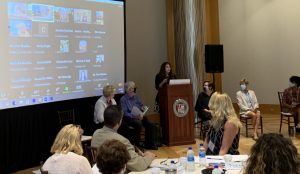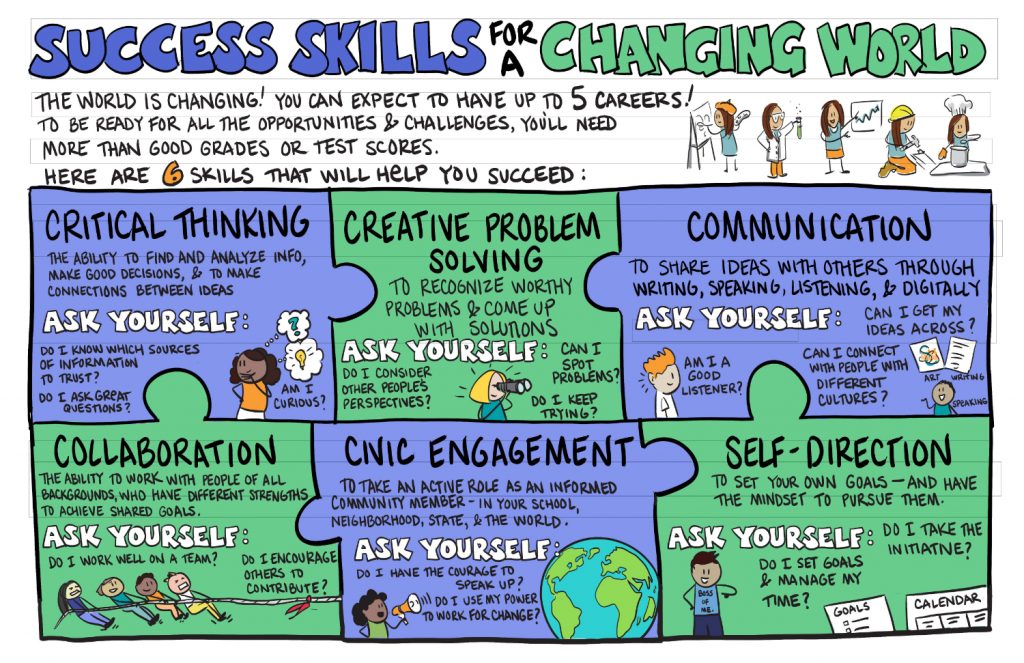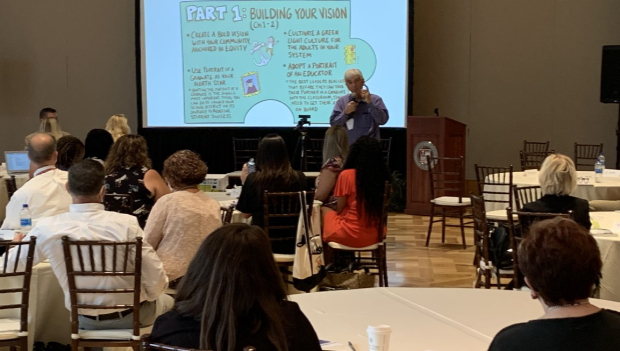As educators look to the new school year they are reflecting on what they have learned during the last year and a half of pandemic learning and thinking about which lessons they want to take with them into the new school year. At a recent kickoff meeting of the 2021-22 Teacher Leader Fellowship Academy (TLFA) at Sacred Heart University in Fairfield, educators had a chance to come together to share their thoughts and reflections.
TLFA Director Betty Sternberg, a former Connecticut commissioner of education, told participants, some of whom attended virtually and others in-person, “We were all presented with an immediate, unanticipated, radical situation that forced us to be creative and innovative. With that great challenge came great opportunities to fundamentally change how and what we taught. Now, with more time to reflect on the experience, we all have the great opportunity and responsibility to influence purposely the shape of what education looks like.”
[Above right, keynote speaker Ken Kay gave an address at the TLFA kickoff titled Building a “Green Light” Culture for Creative Problem Solving.]
The TLFA is a partnership between Sacred Heart, CEA, and partnering schools districts that works with teams of teachers and administrators in those districts. TLFA taps into the expertise of classroom teachers while offering them an empowering, collaborative fellowship that builds teachers’ leadership skills while they remain in the classroom. Simultaneously, TLFA supports administrators in creating a school climate and culture that fosters teacher leadership.

CEA Vice President Joslyn DeLancey addressed in-person and virtual attendees at the kickoff of this year’s Teacher Leader Fellowship Academy.
CEA Vice President Joslyn DeLancey told attendees, “To be a teacher leader is a brave and tremendously needed role in our world of education, so thank you for choosing this journey. It is not easy to be a teacher leader, but we need you, and I’m so excited for the work that you’re about to embark on today and throughout your journey as an educator.”
Wondering what our country would be like if we treated teacher leaders in the same way we exalt and adorn our Olympians, DeLancey said that teacher leaders share the highest levels of talent, flexibility, endurance, skill, creativity, quick pace, risk taking, compassion, sportsmanship, and so many other attributes required of Olympic athletes. “As your union representative, I will learn with you, spot your jumps, cheer for your successes, coach you in your negotiations, hope for your ongoing success, be your shoulder through frustrating moments, and work to keep you safe in all areas of your process,” she said.
Addressing the teachers in the room, Connecticut Association of Public School Superintendents Executive Director Fran Rabinowitz said, “You are magic makers in my book. We are where we are in Connecticut because of your giftedness, because of your commitment, because of your love of children.”
She continued, “I know what you’ve done during the pandemic—I’ve heard from my superintendents. They couldn’t say enough about what teachers have done during the pandemic. We are not going to return to normal; that’s not what we need to do. We need to return to a new normal for our kids.”
Acting Commissioner of Education Charlene Russell-Tucker pledged that she and her agency are there to support educators. “If you’re not at you’re best, then you can’t be at your best for your students and their families,” she said. “You are our partners—your voices matter.”
Greenlighting creativity and innovation
Ken Kay, who has worked for almost two decades promoting a new model of K-12 education, gave a keynote address at the TLFA kickoff titled Building a “Green Light” Culture for Creative Problem Solving.
Kay is the author, with Suzie Boss, of the book Redefining Student Success that is being released this week. The book focuses on the concepts and actions needed to reimagine schools while addressing inequities and helping students develop the skills they need for success.

The success skills poster and other free resources for students, parents, and educators are available at http://redefiningstudentsuccess.org.
Kay asked participants to share with one another how, even within the constraints of pandemic learning, they had found room for creativity and innovation.
A school counselor shared that she asked remote students to create playlists and used digital escape rooms to keep them engaged last year
Another educator shared that checking in on students’ mental well-being became a routine focus of instruction and preceded lessons every day.
Others said that pandemic constraints fostered more collaboration between educators and that there was more intentionality about lessons and activities. Some educators said that remote and hybrid learning drove home in a deeper way the importance of human interaction and connection.
Kay advocates for a “green light” culture where schools and districts feel empowered to innovate. He said that having a green light culture means encouraging a growth mindset for educators as well as for students. Allowing teachers to fail and try again models for students that it’s okay to fail, he said.
“Teachers, principals, and superintendents have to be on this together, this is not a one off sport,” Kay said. “Teachers know if a principal doesn’t give a green light it’s not going to go very far.”
He related the story of a union representative working in a district where the superintendent was encouraging a green light culture, but not all building level administrators were on board. The union representative was able to work with the superintendent to identify which schools were not getting a green light so the superintendent could address the problem.
Attendees spoke to the importance of trust to nurture a green light culture, and the need for breaking down silos in school districts to build trust at all levels.
“It is not enough to have a voice if you do not trust that it is being heard or considered,” one participant said.
“It’s hard to trust those you do not know,” another said. “Students, teachers, administrators, superintendents, the board of education, and community—trust at all levels is a prerequisite for taking the risks needed to innovate.”
Click here to learn more about the Teacher Leader Fellowship Academy at Sacred Heart University.







